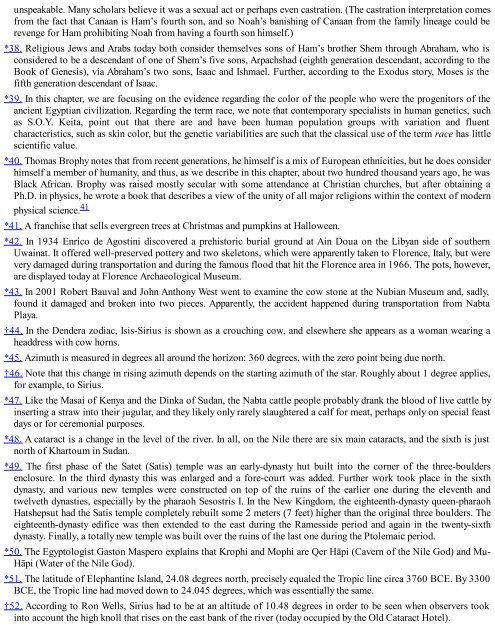Black Genesis: The Prehistoric Origins of Ancient Egypt
Black Genesis: The Prehistoric Origins of Ancient Egypt
Black Genesis: The Prehistoric Origins of Ancient Egypt
Create successful ePaper yourself
Turn your PDF publications into a flip-book with our unique Google optimized e-Paper software.
unspeakable. Many scholars believe it was a sexual act or perhaps even castration. (<strong>The</strong> castration interpretation comes<br />
from the fact that Canaan is Ham’s fourth son, and so Noah’s banishing <strong>of</strong> Canaan from the family lineage could be<br />
revenge for Ham prohibiting Noah from having a fourth son himself.)<br />
*38. Religious Jews and Arabs today both consider themselves sons <strong>of</strong> Ham’s brother Shem through Abraham, who is<br />
considered to be a descendant <strong>of</strong> one <strong>of</strong> Shem’s five sons, Arpachshad (eighth generation descendant, according to the<br />
Book <strong>of</strong> <strong>Genesis</strong>), via Abraham’s two sons, Isaac and Ishmael. Further, according to the Exodus story, Moses is the<br />
fifth generation descendant <strong>of</strong> Isaac.<br />
*39. In this chapter, we are focusing on the evidence regarding the color <strong>of</strong> the people who were the progenitors <strong>of</strong> the<br />
ancient <strong>Egypt</strong>ian civilization. Regarding the term race, we note that contemporary specialists in human genetics, such<br />
as S.O.Y. Keita, point out that there are and have been human population groups with variation and fluent<br />
characteristics, such as skin color, but the genetic variabilities are such that the classical use <strong>of</strong> the term race has little<br />
scientific value.<br />
*40. Thomas Brophy notes that from recent generations, he himself is a mix <strong>of</strong> European ethnicities, but he does consider<br />
himself a member <strong>of</strong> humanity, and thus, as we describe in this chapter, about two hundred thousand years ago, he was<br />
<strong>Black</strong> African. Brophy was raised mostly secular with some attendance at Christian churches, but after obtaining a<br />
Ph.D. in physics, he wrote a book that describes a view <strong>of</strong> the unity <strong>of</strong> all major religions within the context <strong>of</strong> modern<br />
physical science. 41<br />
*41. A franchise that sells evergreen trees at Christmas and pumpkins at Halloween.<br />
*42. In 1934 Enrico de Agostini discovered a prehistoric burial ground at Ain Doua on the Libyan side <strong>of</strong> southern<br />
Uwainat. It <strong>of</strong>fered well-preserved pottery and two skeletons, which were apparently taken to Florence, Italy, but were<br />
very damaged during transportation and during the famous flood that hit the Florence area in 1966. <strong>The</strong> pots, however,<br />
are displayed today at Florence Archaeological Museum.<br />
*43. In 2001 Robert Bauval and John Anthony West went to examine the cow stone at the Nubian Museum and, sadly,<br />
found it damaged and broken into two pieces. Apparently, the accident happened during transportation from Nabta<br />
Playa.<br />
†44. In the Dendera zodiac, Isis-Sirius is shown as a crouching cow, and elsewhere she appears as a woman wearing a<br />
headdress with cow horns.<br />
*45. Azimuth is measured in degrees all around the horizon: 360 degrees, with the zero point being due north.<br />
†46. Note that this change in rising azimuth depends on the starting azimuth <strong>of</strong> the star. Roughly about 1 degree applies,<br />
for example, to Sirius.<br />
*47. Like the Masai <strong>of</strong> Kenya and the Dinka <strong>of</strong> Sudan, the Nabta cattle people probably drank the blood <strong>of</strong> live cattle by<br />
inserting a straw into their jugular, and they likely only rarely slaughtered a calf for meat, perhaps only on special feast<br />
days or for ceremonial purposes.<br />
*48. A cataract is a change in the level <strong>of</strong> the river. In all, on the Nile there are six main cataracts, and the sixth is just<br />
north <strong>of</strong> Khartoum in Sudan.<br />
*49. <strong>The</strong> first phase <strong>of</strong> the Satet (Satis) temple was an early-dynasty hut built into the corner <strong>of</strong> the three-boulders<br />
enclosure. In the third dynasty this was enlarged and a fore-court was added. Further work took place in the sixth<br />
dynasty, and various new temples were constructed on top <strong>of</strong> the ruins <strong>of</strong> the earlier one during the eleventh and<br />
twelveth dynasties, especially by the pharaoh Sesostris I. In the New Kingdom, the eighteenth-dynasty queen-pharaoh<br />
Hatshepsut had the Satis temple completely rebuilt some 2 meters (7 feet) higher than the original three boulders. <strong>The</strong><br />
eighteenth-dynasty edifice was then extended to the east during the Ramesside period and again in the twenty-sixth<br />
dynasty. Finally, a totally new temple was built over the ruins <strong>of</strong> the last one during the Ptolemaic period.<br />
*50. <strong>The</strong> <strong>Egypt</strong>ologist Gaston Maspero explains that Krophi and Mophi are Qer Hāpi (Cavern <strong>of</strong> the Nile God) and Mu-<br />
Hāpi (Water <strong>of</strong> the Nile God).<br />
*51. <strong>The</strong> latitude <strong>of</strong> Elephantine Island, 24.08 degrees north, precisely equaled the Tropic line circa 3760 BCE. By 3300<br />
BCE, the Tropic line had moved down to 24.045 degrees, which was essentially the same.<br />
†52. According to Ron Wells, Sirius had to be at an altitude <strong>of</strong> 10.48 degrees in order to be seen when observers took<br />
into account the high knoll that rises on the east bank <strong>of</strong> the river (today occupied by the Old Cataract Hotel).


